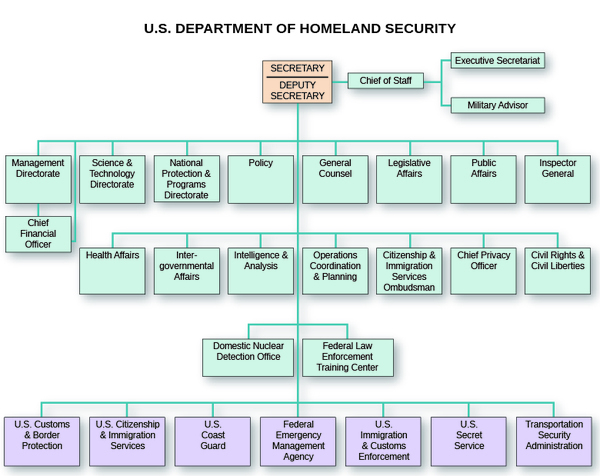| << Chapter < Page | Chapter >> Page > |
The attacks of September 11 awakened many to the reality that the end of the Cold War did not mean an end to foreign violent threats. Some Americans grew wary of alleged possible enemies in their midst and hate crimes against Muslim Americans—and those thought to be Muslims—surged in the aftermath. Fearing that terrorists might strike within the nation’s borders again, and aware of the chronic lack of cooperation among different federal law enforcement agencies, Bush created the Office of Homeland Security in October 2001. The next year, Congress passed the Homeland Security Act , creating the Department of Homeland Security, which centralized control over a number of different government functions in order to better control threats at home ( [link] ). The Bush administration also pushed the USA Patriot Act through Congress, which enabled law enforcement agencies to monitor citizens’ e-mails and phone conversations without a warrant.

The Bush administration was fiercely committed to rooting out threats to the United States wherever they originated, and in the weeks after September 11, the Central Intelligence Agency (CIA) scoured the globe, sweeping up thousands of young Muslim men. Because U.S. law prohibits the use of torture, the CIA transferred some of these prisoners to other nations—a practice known as rendition or extraordinary rendition—where the local authorities can use methods of interrogation not allowed in the United States.
While the CIA operates overseas, the Federal Bureau of Investigation (FBI) is the chief federal law enforcement agency within U.S. national borders. Its activities are limited by, among other things, the Fourth Amendment, which protects citizens against unreasonable searches and seizures. Beginning in 2002, however, the Bush administration implemented a wide-ranging program of warrantless domestic wiretapping, known as the Terrorist Surveillance Program, by the National Security Agency (NSA). The shaky constitutional basis for this program was ultimately revealed in August 2006, when a federal judge in Detroit ordered the program ended immediately.
The use of unconstitutional wire taps to prosecute the war on terrorism was only one way the new threat challenged authorities in the United States. Another problem was deciding what to do with foreign terrorists captured on the battlefields in Afghanistan and Iraq. In traditional conflicts, where both sides are uniformed combatants, the rules of engagement and the treatment of prisoners of war are clear. But in the new war on terror, extracting intelligence about upcoming attacks became a top priority that superseded human rights and constitutional concerns. For that purpose, the United States began transporting men suspected of being members of al-Qaeda to the U.S. naval base at Guantanamo Bay, Cuba, for questioning. The Bush administration labeled the detainees “unlawful combatants,” in an effort to avoid affording them the rights guaranteed to prisoners of war, such as protection from torture, by international treaties such as the Geneva Conventions. Furthermore, the Justice Department argued that the prisoners were unable to sue for their rights in U.S. courts on the grounds that the constitution did not apply to U.S. territories. It was only in 2006 that the Supreme Court ruled in Hamdan v. Rumsfeld that the military tribunals that tried Guantanamo prisoners violated both U.S. federal law and the Geneva Conventions.
George W. Bush’s first term in office began with al-Qaeda’s deadly attacks on the World Trade Center and the Pentagon on September 11, 2001. Shortly thereafter, the United States found itself at war with Afghanistan, which was accused of harboring the 9/11 mastermind, Osama bin Laden, and his followers. Claiming that Iraq’s president Saddam Hussein was building weapons of mass destruction, perhaps with the intent of attacking the United States, the president sent U.S. troops to Iraq as well in 2003. Thousands were killed, and many of the men captured by the United States were imprisoned and sometimes tortured for information. The ease with which Hussein was deposed led the president to declare that the mission in Iraq had been accomplished only a few months after it began. He was, however, mistaken. Meanwhile, the establishment of the Office of Homeland Security and the passage of the Homeland Security Act and USA Patriot Act created new means and levels of surveillance to identify potential threats.

Notification Switch
Would you like to follow the 'U.s. history' conversation and receive update notifications?